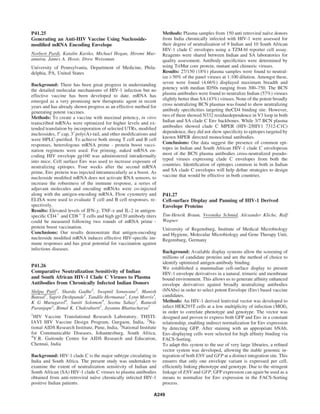
Indo-SA HIVR4P
- 1. P41.25 Generating an Anti-HIV Vaccine Using Nucleoside- modified mRNA Encoding Envelope Norbert Pardi, Katalin Kariko, Michael Hogan, Hiromi Mur- amatsu, James A. Hoxie, Drew Weissman University of Pennsylvania, Department of Medicine, Phila- delphia, PA, United States Background: There has been great progress in understanding the detailed molecular mechanisms of HIV-1 infection but no effective vaccine has been developed to date. mRNA has emerged as a very promising new therapeutic agent in recent years and has already shown progress as an effective method for generating potent vaccines. Methods: To create a vaccine with maximal potency, in vitro transcribed mRNAs were optimized for higher levels and ex- tended translation by incorporation of selected UTRs, modified nucleosides, 5¢ cap, 3¢ poly(A)-tail, and other modifications and were HPLC-purified. To achieve both strong T cell and B cell responses, heterologous mRNA prime - protein boost vacci- nation regimens were used. For priming, naked mRNA en- coding HIV envelope gp160 was administered intradermally into mice. Cell surface Env was used to increase exposure of neutralizing epitopes. Four weeks after the second mRNA prime, Env protein was injected intramuscularly as a boost. As nucleoside modified mRNA does not activate RNA sensors, to increase the robustness of the immune response, a series of adjuvant molecules and encoding mRNAs were co-injected along with the antigen-encoding mRNA. Flow cytometry and ELISA were used to evaluate T cell and B cell responses, re- spectively. Results: Elevated levels of IFN-v, TNF-a and IL-2 in antigen- specific CD4+ and CD8+ T cells and high gp120 antibody titers could be measured following two rounds of mRNA prime - protein boost vaccination. Conclusions: Our results demonstrate that antigen-encoding nucleoside modified mRNA induces effective HIV-specific im- mune responses and has great potential for vaccination against infectious diseases. P41.26 Comparative Neutralization Sensitivity of Indian and South African HIV-1 Clade C Viruses to Plasma Antibodies from Chronically Infected Indian Donors Shilpa Patil1 , Sharda Gadhe2 , Swapnil Sonawane2 , Manish Bansal1 , Suprit Deshpande1 , Tandile Hermanus3 , Lynn Morris3 , K G Murugavel4 , Suniti Solomon4 , Seema Sahay2 , Ramesh Paranjape2 , Bimal K. Chakrabarti1 , Jayanta Bhattacharya1 1 HIV Vaccine Translational Research Laboratory, THSTI- IAVI HIV Vaccine Design Program, Gurgaon, India, 2 Na- tional AIDS Research Institute, Pune, India, 3 National Institute for Communicable Diseases, Johannesburg, South Africa, 4 Y.R. Gaitonde Centre for AIDS Research and Education, Chennai, India Background: HIV-1 clade C is the major subtype circulating in India and South Africa. The present study was undertaken to examine the extent of neutralization sensitivity of Indian and South African (SA) HIV-1 clade C viruses to plasma antibodies obtained from anti-retroviral naı¨ve chronically infected HIV-1 positive Indian patients. Methods: Plasma samples from 150 anti retroviral naı¨ve donors from India chronically infected with HIV-1 were assessed for their degree of neutralization of 9 Indian and 10 South African HIV-1 clade C envelopes using a TZM-bl reporter cell assay. Reagents were shared between Indian and SA laboratories for quality assessment. Antibody specificities were determined by using TriMut core protein, mutant and chimeric viruses. Results: 27/150 (18%) plasma samples were found to neutral- ize > 50% of the panel viruses at 1:100 dilution. Amongst these, seven were found (4.66%) displayed maximum breadth and potency with median ID50s ranging from 300–750. The BCN plasma antibodies were found to neutralize Indian (57%) viruses slightly better than SA (43%) viruses. None of the potent broadly cross neutralizing BCN plasmas was found to show neutralizing antibody specificities targeting theCD4 binding site. However, two of them showed N332 residuedependence in V3 loop in both Indian and SA clade C Env backbones. While 3/7 BCN plasma antibodies showed clade C MPER (HIV-2/HIV1 7312-C1C) dependence, they did not show specificity to epitopes targeted by known MPER directed monoclonal antibodies. Conclusions: Our data suggest the presence of common epi- topes in Indian and South African HIV-1 clade C envelopesas most of the BCN plasma antibodies cross-neutralized pseudo- typed viruses expressing clade C envelopes from both the countries. Identification of epitopes common in both in Indian and SA clade C envelopes will help define strategies to design vaccine that would be effective in both countries. P41.27 Cell-surface Display and Panning of HIV-1 Derived Envelope Proteins Tim-Henrik Bruun, Veronika Schmid, Alexander Kliche, Ralf Wagner University of Regensburg, Institute of Medical Microbiology and Hygiene, Molecular Microbiology and Gene Therapy Unit, Regensburg, Germany Background: Available display systems allow the screening of millions of candidate proteins and are the method of choice to identify optimized antigen-antibody binding. We established a mammalian cell-surface display to present HIV-1 envelope derivatives in a natural, trimeric and membrane bound environment. This allows us to generate affinity enhanced envelope derivatives against broadly neutralizing antibodies (bNAbs) in order to select potent Envelope (Env) based vaccine candidates. Methods: An HIV-1 derived lentiviral vector was developed to infect HEK293T cells at a low multiplicity of infection (MOI), in order to correlate phenotype and genotype. The vector was designed and proven to express both GFP and Env in a constant relationship, enabling indirect normalization for Env expression by detecting GFP. After staining with an appropriate bNAb, Env-displaying cells were selected for high affinity binding via FACS-Sorting. To adapt this system to the use of very large libraries, a refined vector system was developed, allowing the stable genomic in- tegration of both ENV and GFP at a distinct integration site. This ensures that only one envelope variant is expressed per cell, efficiently linking phenotype and genotype. Due to the stringent linkage of ENV and GFP, GFP expression can again be used as a means to normalize for Env expression in the FACS-Sorting process. A249